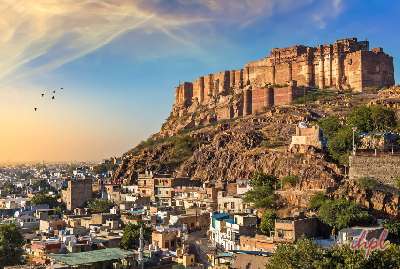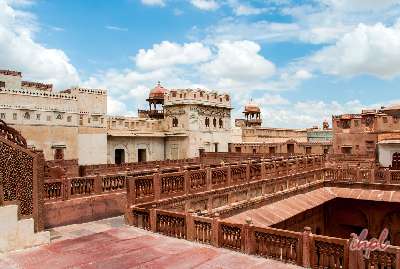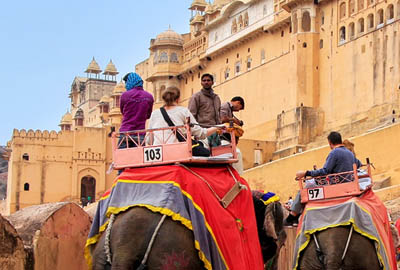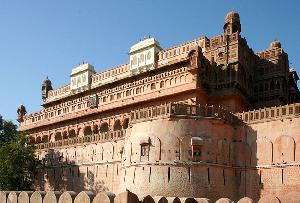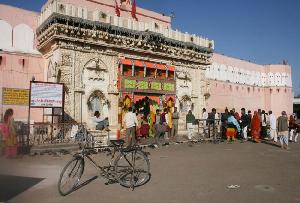Bikaner, a city renowned for its imposing forts, palaces, and temples. The Junagarh Fort, with its intricate architecture, is a must-visit, while the Camel Festival adds a cultural charm to the city. With 34 years of expertise, Indian Holiday brings you the best-customised tour packages and trusted local support, ensuring a journey as royal as Rajasthan itself.
Still, wondering why Indian Holiday is your best choice? Read this: Why Choose a Travel Comp Over an Online Booking Agent? Is It Expensive To Book Through A Travel Company?
Junagarh Fort, located in Bikaner, stands proudly as a symbol of invincibility. Originally called “Chintamani Mahal” until the 20th century, it was subject to repeated invasions in the past but remained unconquered over time.
It got its present name, Junagarh, which means “Old Fort,” in the early 20th century when the royal family shifted to Lalgarh Palace. This is one of those few forts in Rajasthan that is not seated on a hilltop. Instead, the modern city of Bikaner was built around the fort.
It is believed that the first digging ceremony of the fort was held on January 30, 1589 AD, while the foundation was laid on February 17, 1589 AD. The fort’s construction is said to have been completed on January 17, 1594 AD. This fort represents architectural excellence and is an excellent center of art, heritage, culture, and history.
Dive into our Bikaner Guide for everything you need to know for an incredible adventure!
Junagarh Fort History
Rao Bika laid the Junagarh Fort’s foundation in 1478. Earlier, it was only a stone fort. The current Junagarh fort shielded the Bika-built stone fort. In 1472, the mighty stronghold was the focal point of the development of the city of Bikaner.
Foreign foes made numerous attempts to seize it. However, all but one fell short. Finally, Babur’s son Kamran Mirza took control of the impressive fort for one day in 1534 under Rao Jait Singh’s authority.
Best Time to visit Junagarh Fort
October to March is the ideal season to explore Bikaner and Junagarh Fort. Despite the extreme cold in December and January, people can still enjoy visiting the location. However, the hot and muggy weather from April to September prevents tourists from enjoying their trip.
Explore 7 days Delhi Agra Jaipur Forts & Palaces Tour, 10 Days Rajasthan offbeat tour package
Structure of Junagarh Fort
The structures found in the Junagarh Fort are palaces and temples primarily built of red sandstone and marble. The courts, with their courtyards, kiosks, balconies, and windows, allure visitors in large numbers. Most of these have been converted into museums and provide valuable insight into the royal lifestyle of Rajasthan’s erstwhile princes and rulers.
Features of Junagarh Fort
This fort, built in the plains of Bikaner, is rectangular. It consists of 37 bastions and seven gates to ward off enemy attacks. A unique feature of the fort is the intricate stone carvings adorning the red and gold-colored sandstones.
The fort’s interiors are decorated in traditional Rajasthani style, while the fort’s architecture reflects several architectural styles, including Rajput, Gujarat, and Mughal styles of architecture. One can also witness the influence of the British style of architecture in the fort.
The Junagarh Fort has gone through sixteen successive generations of rulers of Bikaner. As a result, one can witness several antique monuments and excellent art objects inside the fort.
The most prominent are the old palaces with their porches, pillars, gates, doors, galleries, and corridors. The palaces here belong to different periods in history and reflect the events and shed light on the past glories of Bikaner.
Top Attractions in Junagarh Fort, Bikaner
The fort has many attractions, including temples, museums, and palaces.
Palaces
- Karan Mahal
- Phool Mahal
- Anup Mahal
- Chandra Mahal
- Ganga Mahal
- Badal Mahal
Temples
- Ratan Behari Temple
- Har Mandir
- Gaj Mandir
Gates
- Karan Pol
- Suraj Pol
- Tripolia Pol
- Daulat Pol
Browse through our Rajasthan Tour Packages from Delhi, Rajasthan Tour Packages from Kolkata
How to Reach Junagarh Fort
Bikaner has good rail and road transport connections to several Indian towns. Although a civil terminal has been built, air transportation has not yet begun. To encourage foreign tourism, the government is working to improve air travel.
Essential information about Junagarh Fort, Bikaner
Famous For: History, Architecture, Photography
Entry Fee:
Indian = 50 INR
Indian (Student Concession) = 30 INR
Foreigner = 300 INR
Foreigner (Student Concession) = 150 INR
Audio Tour = 350 INR
Audio Tour (Student Concession) = 200 INR
Phool Mahal and Chander Mahal = 100 INR
Junagarh Fort Timings: 10 a.m. to 4:30 p.m. daily.
Visiting Duration: 2 to 3 hours
If you plan to visit Junagarh Fort, you must check out our Bikaner tour packages.
Check out Rajasthan Tour Packages, Sand Dunes Tour Packages, Jaipur Tour Packages, Sawai Madhopur Tour Packages



